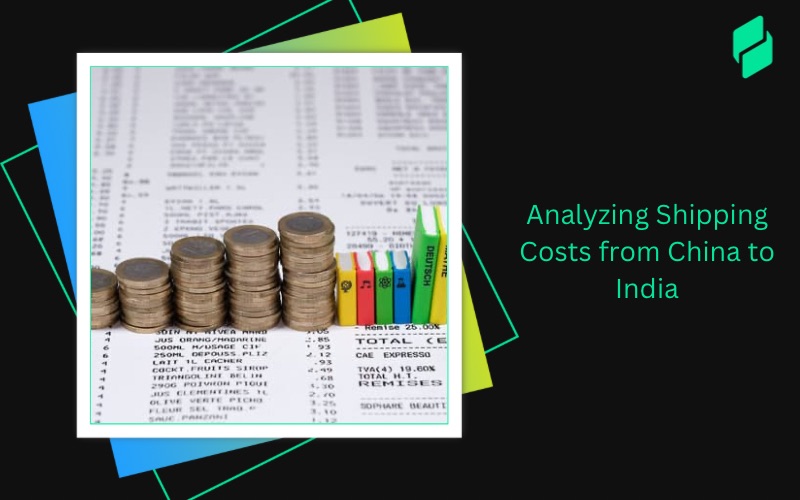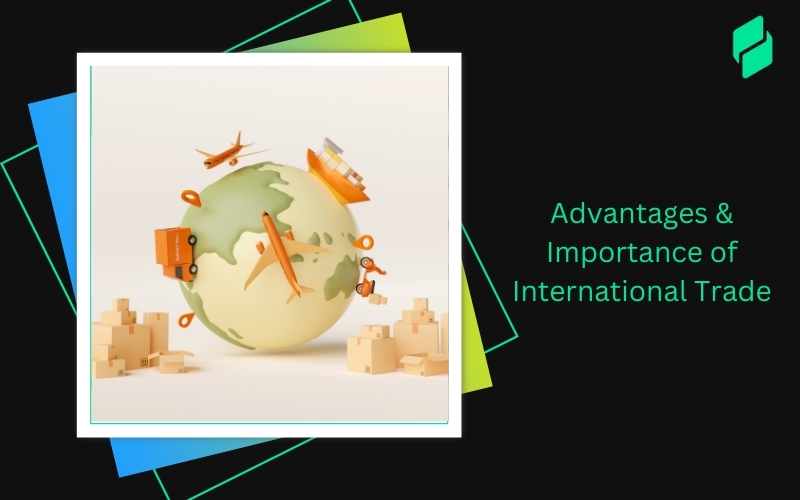Optimize your business: use unlimited savings with Pazago fulfilled now!
Get Started ->When you're planning to transport goods from China to India, one of the first questions that comes to mind is, "How much is this going to cost?" The answer, however, isn't as straightforward as you might hope.
The shipping cost from China to India varies significantly depending on several factors, including the shipping method, the nature of the goods, and the speed at which you need them delivered.
In this article, we'll explore the costs and the various shipping methods that play a pivotal role in determining how swiftly and economically your goods arrive.
2025 Shipping Cost Snapshot: China to India (Average Rates & Transit Times)
When importing or exporting between China and India, your shipping mode determines not just cost, but also delivery time, reliability, and cash-flow impact. Here’s how each option stacks up in 2025.
1. Sea Freight
Sea freight remains the backbone of China–India trade, handling over 70% of total cargo volume.

It’s the most cost-efficient method per unit, making it ideal for bulk, heavy, or non-urgent shipments.
You can either book a Full Container Load (FCL) — for shipments filling most of a 20- or 40-foot container — or a Less-than-Container Load (LCL), where your cargo shares space (and cost) with others.
Transit typically takes 20–35 days, depending on the ports used and sailing schedules. The trade-off is time: slower movement, but far lower cost — up to 70% cheaper than air freight.
Also Read: Understanding Ocean Shipping and Transport Services
2. Air Freight
Air freight is the go-to for time-sensitive or high-value goods such as electronics, fashion, auto parts, or pharmaceuticals.
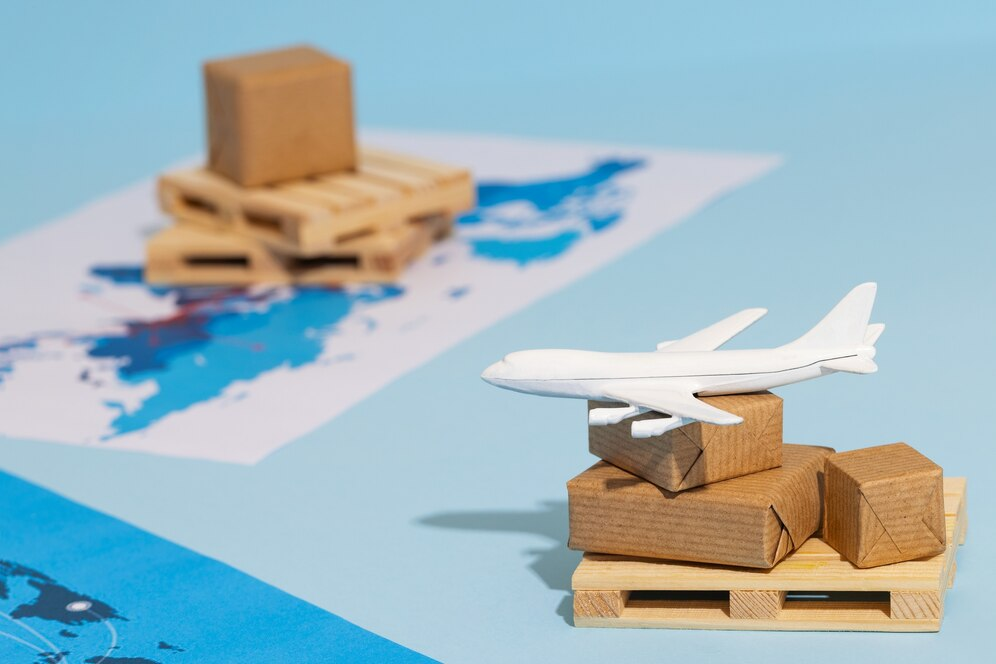
It’s 5–7× faster than sea freight, with door-to-door delivery averaging 3–7 days, though costs can run ₹350–₹615/kg (~$4–7/kg).
Indian SMEs typically use air freight for inventory replenishment or urgent client deliveries where stock-outs would cost more than the freight itself.
While expensive, it offers greater reliability and less exposure to port congestion or weather delays — a key factor for businesses scaling up exports.
Also Read: Cargo Plane Facts and Usage - 10 things you need to know
3. Express Shipping
Express shipping, handled by global carriers like DHL, FedEx, UPS, and Aramex, is the fastest and simplest mode for light parcels and e-commerce orders.

These services are door-to-door, combining pickup, air transit, customs clearance, and last-mile delivery into one tracked process.
Transit times are typically 1–3 days for metro areas (up to 5 for remote regions), and rates average ₹700–₹1,100/kg (~$8–$12.5/kg).
Though premium-priced, express options are invaluable for urgent samples, high-margin sales, or international D2C shipments needing guaranteed timelines.
4. Rail Freight0.

There is no direct rail corridor between China and India due to terrain and border restrictions.
However, a few multimodal experimental routes operate via Kazakhstan, Uzbekistan, and Iran, connecting to western Indian ports like Mundra.
These hybrid sea-rail solutions balance cost and time — generally 25–45 days door-to-door — but come with higher operational risk and limited reliability.
For now, they remain niche, used mainly by large logistics companies testing alternate corridors to reduce dependence on congested maritime routes.
Also Read: Exploring Import Procedures and Regulations from China to India

Before choosing a shipping method, it helps to have a quick overview of the current market rates.
Here’s a snapshot of the average shipping costs from China to India in 2025, across sea, air, and express modes.
All values are benchmarks based on aggregated freight quotes from major Chinese and Indian ports.
Exchange rate used: ₹87.95 ≈ $1 (as of October 2025). Actual rates vary by port pair, season, cargo type, and carrier surcharges.
🧾 Disclaimer: These are indicative averages compiled from forwarder data (Sino-Shipping, ChinaTopFreight, GXpress, and others). Use Pazago Portal to view live route-specific quotes and track fluctuations in real time.
Now that we have a clear snapshot of average shipping prices from China to India, let’s explore how these costs are calculated — and what key factors influence the final freight rate for your shipment.
Sea Freight Costs from China to India in 2025
Sea freight remains the most economical and widely used option for transporting bulk goods between China and India. It’s particularly effective for exporters and importers moving larger, non-urgent shipments where cost efficiency outweighs delivery speed.
In 2025, benchmark rates for Full Container Load (FCL) shipments range between ₹88,000 and ₹1,67,000 for a 20-foot container, and ₹1,32,000 to ₹2,38,000 for a 40-foot container.
For smaller shipments, Less-than-Container Load (LCL) pricing typically falls between ₹7,000 and ₹10,500 per CBM, excluding local handling at origin and destination ports.
Transit times for sea routes usually range from 20 to 35 days, depending on sailing schedules, port congestion, and customs clearance at both ends.
Note: The base freight cost is only one part of your total bill. Port handling, documentation, insurance, and customs clearance can add another 10–15% depending on the nature of cargo and shipping season.
Example:
A 20-foot container of consumer goods shipped from Shenzhen to Nhava Sheva may be quoted around ₹1,25,000 for base ocean freight. Once you include handling and documentation, the total often reaches ₹1,40,000–₹1,45,000.
Quick summary:
Also Read: Cost of 40 Feet Shipping Container In India
Factors Affecting Sea Freight Costs
Several factors influence the shipping cost from China to India:
- Port Charges: These are fees associated with the handling and processing of cargo at the port of origin and destination. They include terminal handling charges, documentation fees, and other port-specific fees.
- Fuel Surcharges: Fluctuations in global oil prices directly affect fuel surcharges, significantly impacting the overall freight cost. It's important to monitor these changes, as they can vary month by month.
- Type of Shipment: The cost will depend on the nature of your cargo, whether you’re shipping standard goods, hazardous materials, or temperature-sensitive products. Special handling requirements or insurance needs can also increase costs.
- Seasonality and Demand: The time of year also plays a role. Shipping rates tend to spike during peak seasons like the Chinese New Year, as demand for shipping containers increases.
- Customs Duties and Taxes: Import taxes and duties in India can significantly increase the total cost. They are based on the type of goods being imported and can range from 5% to 40% of the cargo’s value.
Also Read: Understanding Freight Charges and Costs [2024 Guide]
Maximise Your Savings on Sea Freight!
Sea freight is cost-effective, but are you truly optimising costs? Let Pazago handle your purchase orders, packaging, and documentation to reduce unnecessary expenses and ensure smooth shipping.
Sea freight is cost-effective, but are you truly optimizing costs? Let Pazago manage your purchase orders, logistics, and insurance to reduce unnecessary expenses and ensure smooth shipping. Book and manage everything through the Pazago portal.
Air Freight Costs from China to India in 2025
When delivery speed matters, air freight is the preferred choice for Indian importers. Although it’s more expensive than sea freight, it significantly reduces lead times and helps avoid stockouts — making it ideal for high-value, time-sensitive, or perishable shipments.
In 2025, standard air freight rates between major Chinese and Indian airports typically range from ₹350 to ₹615 per kg (≈ $4–$7 per kg).
The exact price depends on factors such as cargo type, route, airline capacity, and seasonal fuel surcharges.
Transit times for air shipments average 3–7 days (door-to-door), with express handling or direct flights often reducing this to 2–4 days.
Note: Airlines charge based on “chargeable weight” — whichever is higher between actual and volumetric weight.
Bulky but lightweight cargo (e.g., garments, foam packaging) can therefore cost more than expected.
Example:
A 200 kg shipment of electronic components from Guangzhou to Mumbai at ₹450/kg would cost about ₹90,000 in base freight.
After adding fuel, security, and terminal fees (typically 10–20% extra), the total bill may reach ₹1,00,000–₹1,05,000.
Quick Summary:
Factors Contributing to Air Freight Costs
Several factors contribute to the overall cost of air freight:
- Fuel Surcharge: Fuel prices fluctuate based on global oil markets, and these fluctuations are directly passed on to the shipper as a fuel surcharge. This fee is a significant part of the air freight cost and can vary monthly.
- Security Fee: Given the stringent security measures associated with air transport, especially for international shipments, a security fee is added to ensure the cargo complies with all safety regulations.
This fee helps cover the cost of screening and securing the cargo before loading it onto the aircraft. - Terminal Fee: This fee covers cargo handling at the origin and destination airports. It includes the costs associated with loading and unloading the goods and any storage costs if the cargo needs to be held at the terminal before final delivery.
Also Read: Understanding Dimensions and Weight in Air Freight Shipments
Express Shipping Costs from China to India
For businesses that prioritize speed and reliability, express courier services are the fastest way to ship goods from China to India.
Carriers like DHL, FedEx, UPS, and Aramex dominate this segment, offering door-to-door delivery with integrated customs clearance and real-time tracking.
In 2025, express courier rates typically fall between ₹700 and ₹1,100 per kg (≈ $8–$12.5/kg) for small parcels and high-priority shipments.
This range includes most surcharges but can vary based on the package’s weight slab, service level, and destination pin code.
Standard transit times are 1–3 days for metro deliveries, while remote or customs-intensive regions may extend to 3–5 days.
Because express shipments bundle pickup, air transit, customs, and last-mile delivery into one service, they provide unmatched convenience — though at a premium cost.
Example:
A 5 kg parcel of electronic spares sent via DHL Express from Shenzhen to Bangalore might cost around ₹4,500 (₹900/kg) for base freight.
After including fuel and remote-area surcharges, the final invoice can reach ₹4,800–₹5,000, depending on delivery speed and clearance time.
Quick Summary:
Advantages and Use Cases of Express Shipping
Express shipping is ideal for situations where speed is crucial. Some of the main advantages include:
- Speed: Express shipping is the fastest method available, with delivery times ranging from 3 to 5 days. It is perfect for urgent deliveries, such as time-sensitive documents, medical supplies, or high-value goods that cannot afford delays.
- Reliability: Express shipping services often offer strong tracking capabilities and high reliability, ensuring your goods arrive on time and in good condition. This makes them an excellent option for businesses that must maintain strict delivery schedules.
- Convenience: Express shipping generally includes door-to-door service, simplifying the logistics process for businesses by eliminating the need for additional transportation arrangements at either end of the shipment.
- Use Cases: Express shipping is particularly useful for e-commerce businesses, tech companies shipping prototypes or components, and any business that needs to minimise inventory costs by keeping stock levels low and relying on fast replenishment from suppliers.
Get Your Parcels Delivered Fast and Safe!
For urgent shipments, rely on Pazago’s comprehensive trade fulfilment services to ensure quick and reliable express shipping. Track every step and stay informed.
Fast-Track Your Express Shipping
Also Read: Top Delivery Management Software Tools
Transit Times and Their Impact on Shipping Costs from China to India
Transit time is a critical factor that can significantly impact your overall costs when evaluating shipping options from China to India.
Here’s a table comparing the transit times for different shipping methods from China to India:
Also Read: Guide on Calculating Ocean Freight Transit Times
Factors Leading to Delays and Their Cost Implications
Several factors can cause delays in shipping, each with its implications for your overall costs:
- Port Congestion: Busy ports, especially during peak seasons, can experience significant delays. This extends the transit time and increases costs due to port storage fees and potential demurrage charges.
- Customs Clearance: Complicated customs procedures or incorrect documentation can result in delays. To avoid these additional costs, ensuring accurate paperwork and understanding local regulations is crucial.
- Weather Conditions: Unpredictable weather, such as storms or typhoons, can delay sea freight, while extreme weather conditions can also impact air and rail freight. These delays often lead to increased insurance costs and potential spoilage of perishable goods.
- Labour Strikes and Political Instability: Labor strikes at ports or political instability along the route can disrupt schedules, leading to unexpected delays and increased shipping costs.
Minimise Delays and maximise Efficiency!
Worried about delays? Use Pazago’s real-time tracking and proactive risk management features to stay ahead of potential disruptions. Keep your shipments on time, every time.
Track your sea and air freight shipments in real-time and manage risks proactively with Pazago. Book your freight through Pazago portal and get expert guidance from a team with 15+ years of experience to choose the right shipping mode.
Factors Affecting Overall Shipping Costs from China to India
Shipping costs between China and India can fluctuate considerably — even for the same cargo type — depending on several operational, market, and seasonal factors.
Understanding these cost drivers helps you budget accurately, negotiate better with freight forwarders, and avoid unexpected surcharges that inflate your total landed cost.
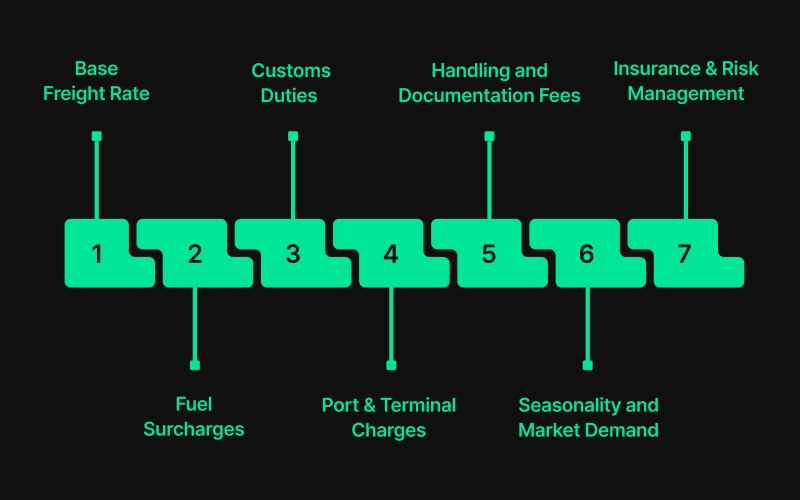
1. Base Freight Rate
The base freight rate forms the foundation of your shipping cost. It’s calculated based on weight, volume, and route distance.
For sea shipments, this is quoted per container (FCL) or per cubic meter (LCL), while air and express shipments are priced per kilogram.
Key Influencers:
- Cargo volume and weight: Larger or heavier consignments naturally cost more to move.
- Port pair and distance: Routes from inland China (like Chongqing or Chengdu) to Indian ports cost more than coastal routes such as Shenzhen–Nhava Sheva.
- Container utilization: Underutilized containers (e.g., half-filled FCLs) drive up cost per unit.
Example: A 20′ container between Shanghai and Nhava Sheva can range from ₹90,000 to ₹1,50,000 depending on space availability and sailing schedules.
Also Read: Calculating Costs for Oversize Load Shipping and Freight Rates
2. Fuel Surcharges
Fuel is one of the most volatile components of global freight pricing. Carriers adjust their Bunker Adjustment Factor (BAF) for sea freight or Fuel Surcharge (FSC) for air freight based on crude oil fluctuations.
Typical Range:
Fuel surcharges can add 5–20% to your total freight bill, depending on oil market trends and carrier policies.
Monitoring these surcharges is essential, especially for long-term contracts, to avoid budget shocks.
Also Read: Understanding Transportation Charges and Their Different Types
3. Customs Duties and Import Taxes
Duties and taxes are non-negotiable costs applied by Indian Customs based on your product’s HS code, declared value, and origin.
They can account for 5–40% of your total import cost, significantly affecting your landed price.
Understanding tariff structures, GST applicability, and exemptions upfront prevents post-arrival cost escalation.
Tip: Always calculate the CIF value (Cost + Insurance + Freight) before estimating duty — as taxes are assessed on the CIF base.
4. Port and Terminal Charges
At both ends of the journey, you’ll face terminal handling, documentation, and port charges.
In India, these typically range from ₹3,000–₹15,000 per container, depending on the port, storage duration, and equipment used.
Delays during loading, unloading, or clearance can attract demurrage or detention fees — avoidable through proactive coordination.
5. Handling and Documentation Fees
From pickup to delivery, your goods change hands multiple times — at warehouses, ports, and customs checkpoints.
Each stage adds minor handling or inspection charges that, combined, can add ₹2,500–₹10,000 per container.
Digitally managing documents (like invoices, packing lists, and certificates) through platforms such as Pazago Portal helps eliminate human errors and avoid re-handling costs.
6. Seasonality and Market Demand
Shipping costs are cyclical. Rates tend to spike during Chinese New Year, Diwali, or peak export months (Sept–Dec) when demand for containers outstrips supply.
Booking space in advance or choosing off-peak weeks can reduce total costs by 10–15%.
7. Insurance and Risk Management
Cargo insurance adds a small percentage (typically 0.5–1% of cargo value) but protects you against damage, loss, or delays.
For high-value shipments, it’s a must-have, not an optional cost.
Also Read: Understanding Verified Gross Mass (VGM) in Shipping
Practical Tips to Estimate and Budget Shipping Costs
To stay cost-accurate and avoid hidden surcharges:

- Get multiple quotes. Compare 2–3 forwarders or platforms (like Pazago) to benchmark true market rates.
- Factor in surcharges. Include fuel, terminal, and handling fees while budgeting — not just base freight.
- Plan around peak seasons. Avoid Chinese New Year and monsoon port congestion if your delivery timeline allows.
- Choose the right mode. LCL or consolidated air can be cheaper than half-filled FCL or express parcels.
- Use digital calculators. Tools within Pazago Portal offer live rate visibility, estimated duties, and end-to-end landed cost prediction.
Gain Clarity on Your True Freight Costs
Stop losing margin to hidden charges and last-minute rate hikes.
With Pazago’s transparent rate engine, you can view all cost components upfront — from base freight to taxes — and choose the optimal mode for every shipment.
[Get a Clear Cost Breakdown in the Pazago Portal →]
Import Taxes and Duties from China to India
Understanding the various taxes and duties involved when importing goods from China to India is crucial to effectively managing costs.
Here's a breakdown of the key components of import taxes and duties you should consider:
Also Read: Definition and Types of Customs Law and Trade Barriers
Calculating the Total Import Duty
To calculate the total import duty, you would typically:
- Start with the Assessable Value: Add the cost of the goods, freight, and insurance.
- Apply BCD: Calculate the BCD on the assessable value.
- Add Social Welfare Surcharge: Apply 10% of the BCD.
- Calculate IGST: Apply the IGST rate to the total of the assessable value plus BCD and Social Welfare Surcharge.
- Add Other Duties (if applicable): Include any Anti-Dumping or Safeguard duties.
Example
If you're importing goods worth ₹5,00,000 with a BCD of 10%, an IGST of 18%, and a Social Welfare Surcharge of 10%, your calculations will look something like this:
- Assessable Value: ₹5,00,000
- BCD (10%): ₹50,000
- Social Welfare Surcharge (10% of BCD): ₹5,000
- Total before IGST: ₹5,55,000
- IGST (18%): ₹99,900
- Total Import Duty Payable: ₹1,54,900
Also Read: Decoding the Customs Act 1962: A Comprehensive Guide
Duty Percentages by Product Category and Their Impact on Overall Shipping Costs from China to India
The specific duty percentage applicable to your product category significantly determines the shipping cost when importing goods from China to India.
Here's an overview of how these duties are structured and their impact on your shipping expenses:
Also Read: List Of Profitable & Best Product To Export From India
How These Duties Impact Shipping Costs
The duties applied based on the product category directly influence the overall shipping cost from China to India. For instance, a high-duty category like automobiles can nearly double the shipping cost once all taxes and surcharges are included.
Conversely, importing pharmaceuticals, which often enjoy lower duties, will have a minimal impact on your total shipping expenses.
Navigate Import Duties with Ease!
Simplify the complexities of import taxes and duties with Pazago’s expert documentation and customs handling services, you can simplify the complexities of import taxes and duties, ensure compliance, and avoid costly delays.
Also Read: Understanding The Applicability And Exemptions Of GST On Ocean Freight
Door-to-door shipping from China to India
For Indian SMEs managing complex imports, door-to-door shipping offers the simplest and most reliable logistics experience.

It covers pickup, transportation, customs clearance, and final delivery — all managed by one provider under a single quote.
This eliminates the need to coordinate multiple freight forwarders, trucking companies, and customs agents.
Key Benefits of Door-to-Door Shipping
- End-to-End Convenience
From factory pickup in China to doorstep delivery in India, every stage is handled by a single logistics partner.
This means fewer intermediaries, less communication lag, and reduced risk of paperwork errors. - Time Efficiency
By streamlining operations under one provider, transit time is reduced by 10–20% compared to managing separate vendors.
It’s especially valuable for SMEs without dedicated logistics teams who want shipments to move seamlessly. - Cost Transparency
Door-to-door quotes are typically all-inclusive — covering freight, customs, and last-mile delivery.
This gives importers a clearer sense of total landed cost upfront, without surprise port or handling fees. - Lower Risk and Full Accountability
Since one logistics partner is responsible for the cargo throughout its journey, accountability is higher.
Damage claims, delays, or documentation issues are easier to resolve when a single entity manages the process.
Also Read: Preventing Shipping Damage: Common Causes and Tips
Typical Cost Considerations (2025)
Door-to-door shipping costs depend on the mode (sea, air, or express) and cargo size:
- Sea freight door-to-door for FCL shipments averages ₹1.4–₹2.2 lakh per 20′ container (including pickup, customs, and delivery).
- Air freight door-to-door ranges ₹480–₹750 per kg, depending on urgency, handling needs, and customs complexity.
- Express couriers like DHL or FedEx offer fixed door-to-door rates between ₹700 and ₹1,100 per kg for parcels under 30 kg.
These rates typically include pickup, freight, clearance, insurance, and last-mile delivery — though exact costs may vary with destination, packaging, and commodity type.
Why SMEs Prefer Door-to-Door Services
For small and mid-sized importers who lack internal logistics teams, door-to-door models remove the guesswork from international trade.
They minimize administrative effort, prevent customs errors, and ensure faster delivery cycles — essential for consistent supply chain operations.
Simplify Door-to-Door Shipping with Pazago
With Pazago Portal, Indian exporters and importers can now book complete door-to-door shipments directly from China to India — with transparent pricing, automated documentation, and real-time tracking.
From pickup scheduling to customs compliance and delivery confirmation, every stage is visible in one dashboard.
Experience truly seamless trade logistics — with Pazago managing every step.
[Explore Door-to-Door Solutions →]
Role of Freight Forwarders and the Importance of Reliable Logistics Partners in Shipping from China to India
Shipping goods from China to India can be a complicated process. That’s where freight forwarders and reliable logistics partners come in—they make the entire shipping process smoother and more efficient.
The Role of Freight Forwarders
1. Manage the Shipping Process: Freight forwarders handle everything from picking up goods at the supplier’s warehouse in China to delivering them to your destination in India. They coordinate all the steps, including customs clearance and transportation.
2. Expertise in Customs: Customs regulations can be tricky, but freight forwarders are experts in navigating these rules. They ensure all paperwork is correct and your shipment complies with the necessary laws, helping to avoid delays and extra costs.
3. Cost Optimization: Freight forwarders can often negotiate better shipping rates and suggest the most cost-effective routes and methods. This can save you a lot of money, especially when shipping large quantities.
4. Handling Problems: If something goes wrong—like a delay or a sudden change in regulations—freight forwarders know how to quickly find solutions, keeping your shipment on track.
Also Read: Understanding the Freight Forwarding Process: Key Stages and Types
Why Reliable Logistics Partners Matter
1. Timely Deliveries: A reliable logistics partner ensures your goods arrive on time, which is crucial for keeping your supply chain running smoothly and avoiding additional costs.
2. Efficient Supply Chain: Good logistics partners make the shipping process more efficient, reducing the shipping cost from China to India and smoothing your business operations.
3. Visibility and Tracking: Reliable partners provide real-time updates on your shipment, so you always know where your goods are, helping you plan better.
4. Lower Risks and Costs: They offer insurance options to protect your shipment and ensure all costs are clear upfront so you don’t face unexpected fees.
Partner with Experts, Ship with Confidence!
Pazago’s reliable logistics services ensure smooth coordination from China to India. Benefit from our expertise in managing every step of your shipping process.
How Pazago Simplifies Global Trade for Indian Exporters and Importers
The Pazago Portal is a powerful, all-in-one platform designed to simplify and efficiently manage international shipping and logistics.
Whether you’re shipping goods from China to India or coordinating global trade routes, Pazago provides everything you need to streamline the process in one easy-to-use interface.
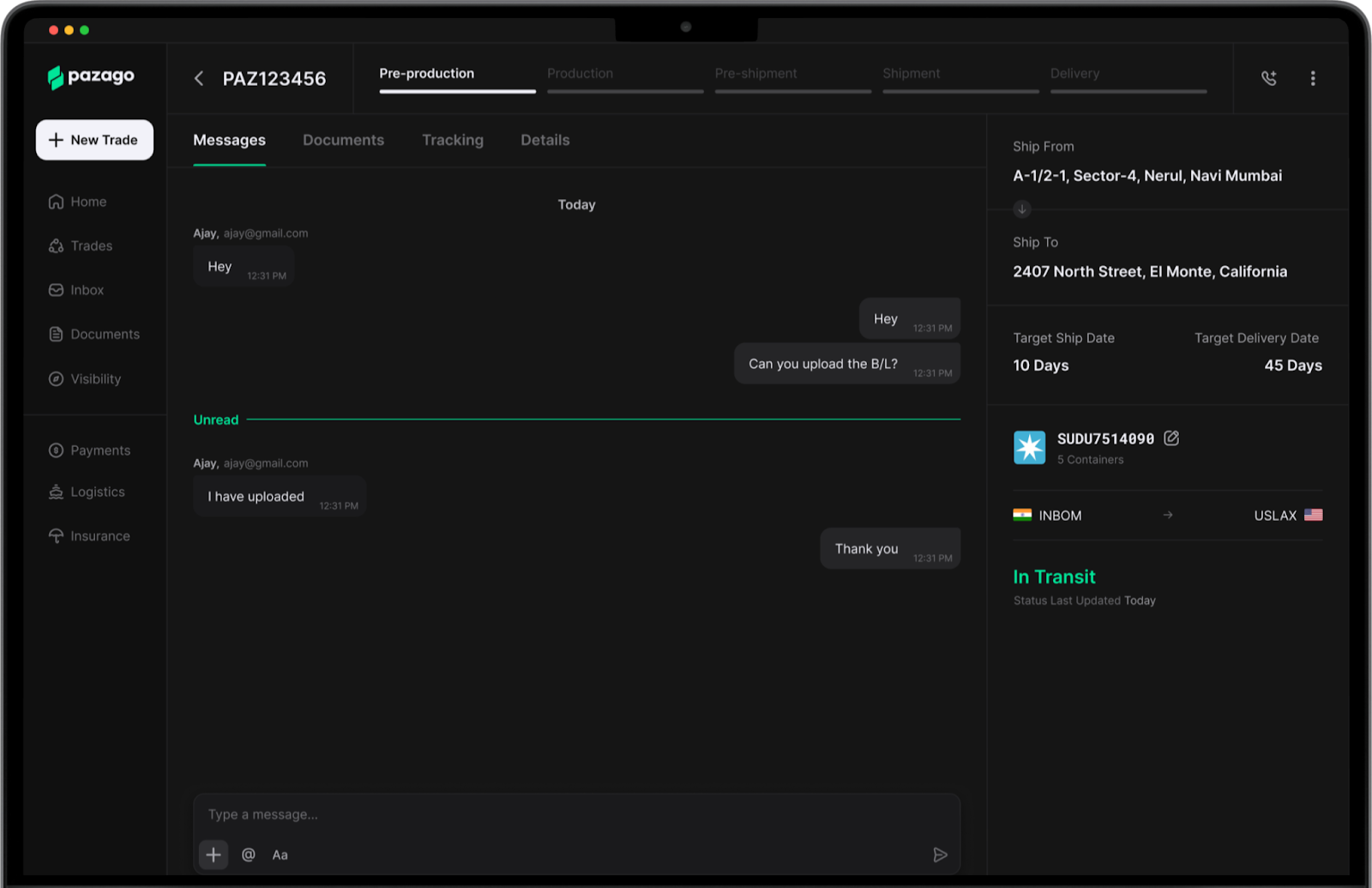
Key Features of the Pazago Portal
- Logistics Management: Handle every aspect of your shipping process, from booking sea and air freight to ensuring on-time delivery.
- Real-Time Tracking: Monitor your shipments in real-time, whether by sea or air, so you always know where your cargo is.
- Documentation Handling: Manage all your shipping documents, including purchase orders, through a single platform, reducing paperwork and errors.
- Insurance and Risk Management: The portal offers integrated insurance options and proactive risk management features, allowing you to protect your shipments.
- Financial Management: Seamlessly handle FOREX conversions and payments, ensuring smooth financial transactions.
- Quality Control: Arrange for quality inspections directly through the portal to ensure your shipments meet all necessary standards.
- Simple Interface: The portal is designed to be user-friendly, making it easy to manage even the most complex shipping operations without needing multiple tools.
Why Choose Pazago
The Pazago Portal simplifies your entire shipping process. It offers seamless coordination of logistics, real-time tracking, documentation handling, insurance, financial management, and quality control—all in one place.
With over 15 years of experience backing the platform, Pazago ensures your shipments are managed by experts, giving you confidence in every step of the process.
Conclusion
Shipping from China to India might seem overwhelming, but it doesn’t have to be.
You can streamline the process by understanding the various shipping options, estimating costs accurately, and working with reliable logistics partners.
Door-to-door services simplify things even further, ensuring your goods arrive safely and on time.
It’s all about careful planning, knowing what to expect, and choosing the right partners to help you navigate the complexities of international shipping.
Streamline Your Shipping, Maximize Your Gains!
Shipping from China to India doesn’t have to be complex. Let Pazago handle the logistics so you can focus on growing your business.
Ready to simplify your trade?
Start Shipping Smarter with Pazago
FAQs: Shipping Cost from China to India (2025)
1. What is the average shipping cost from China to India in 2025?
As of 2025, the average sea freight cost from China to India ranges between ₹88,000 and ₹1.67 lakh for a 20-foot container and ₹1.32 lakh to ₹2.38 lakh for a 40-foot container. Air freight rates generally fall between ₹350 and ₹615 per kilogram, while express courier services like DHL and FedEx cost around ₹700 to ₹1,100 per kilogram, depending on the destination and service speed.
2. Which is the cheapest way to ship goods from China to India?
The cheapest way to ship goods from China to India is by sea freight, especially for bulk or non-urgent cargo. It is significantly more economical than air or express shipping, often costing up to 70 percent less per unit. Although it takes longer—typically 20 to 35 days—it offers the best balance of capacity and cost efficiency for large shipments.
3. How long does it take to ship from China to India?
The average transit time from China to India depends on the mode of transport. Sea freight usually takes between 20 and 35 days, while air freight averages 3 to 7 days. Express courier services deliver parcels within 1 to 3 days to major metro cities, extending up to 5 days for remote locations. Multimodal or rail-linked routes can take around 25 to 45 days, depending on border clearance and transshipment points.
4. Is there a direct rail route between China and India?
There is currently no direct rail corridor between China and India due to geographical and border restrictions. However, several multimodal routes combining rail and sea transport are being explored via Central Asia, Kazakhstan, and Iran. These routes generally take 25 to 45 days and are still considered experimental, used mainly by large logistics operators seeking alternatives to traditional maritime routes.
5. What factors affect the shipping cost from China to India?
Shipping costs are influenced by a combination of factors such as the shipping method, cargo weight and volume, port pair, and distance. Market demand, fuel surcharges, customs duties, and seasonal trends like the Chinese New Year or Diwali can also cause price fluctuations. Additionally, documentation, insurance, and port handling charges contribute to the final landed cost.
6. What taxes or duties apply when importing goods from China to India?
Importing goods from China to India attracts several taxes and duties, including the Basic Customs Duty (typically 5–10 percent), Integrated GST (ranging from 5–28 percent), and a Social Welfare Surcharge of 10 percent on the BCD. Some goods may also face anti-dumping or safeguard duties depending on the category. All duties are calculated on the CIF value, which includes the cost, insurance, and freight components.


.png)


